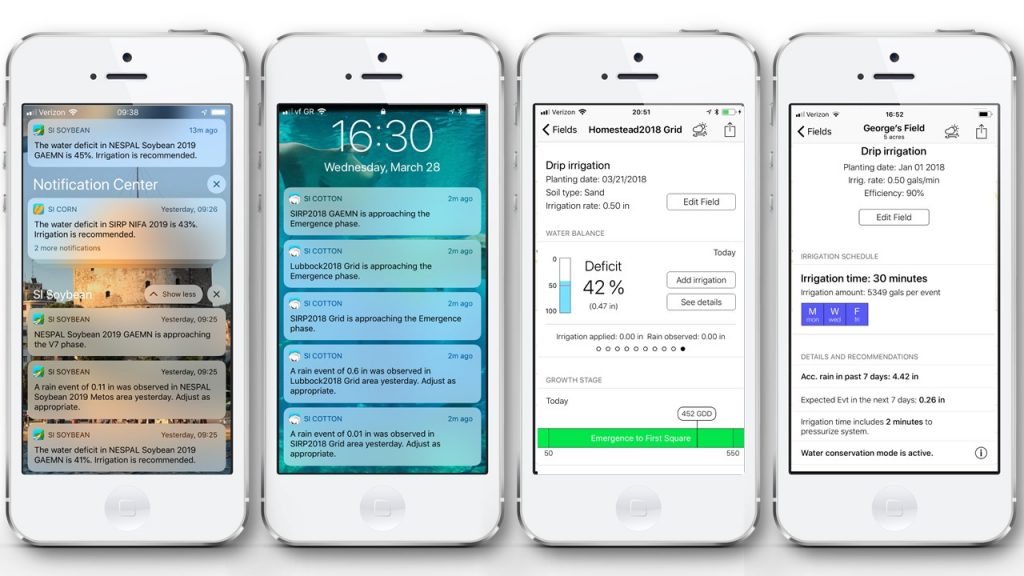
By Vasileios Liakos and George Vellidis
Ample water is a critical input needed to grow high-yielding, high-quality crops. Today, irrigated agriculture represents 20 percent of the total cultivated land, but contributes 40 percent of the total food produced worldwide. Due to overuse, droughts and growing demand by urban and industrial users, competition for available fresh water supplies is rapidly increasing. California’s Central Valley and the Southern Great Plains are prime examples of agricultural areas where food production is threatened by decreasing availability of irrigation water.
Despite this, relatively few growers use science-based irrigation scheduling methods. Data from the most recent U.S. Department of Agriculture National Agricultural Statistics Service Farm and Ranch Irrigation Survey indicate that more than 72 percent of irrigated farms in the United States still rely either on a fixed schedule or on visual cues of plant stress such as wilting. Only 28 percent of farms use any type of science-based irrigation scheduling tools, and even fewer (12 percent) use soil moisture sensors.
The extent to which improper timing and amount of irrigation applied can result in yield losses has been documented for many crops. For example, researchers in Tennessee found that improper timing of irrigation in cotton may result in yield losses of between $150 to $750 per acre.
There are many inhibiting factors preventing adoption of irrigation scheduling tools, including cost of soil moisture sensors, labor involved with installing and removing them, regular data entry required of web-based scheduling tools, etc. The ubiquitous use of smartphones provides a platform on which to deliver sophisticated yet easy-to-use irrigation scheduling tools. Smartphone applications (apps) are ideal tools for irrigation scheduling because they are with the user at all times, are readily accessible and engage the user through notifications.
A team of University of Florida and University of Georgia scientists and engineers developed a suite of SmartIrrigation apps that provide real-time irrigation schedules for avocado, blueberry, citrus, corn, cotton, soybean, strawberry, turf and vegetables. The vegetable app includes squash, tomato and watermelon grown on plastic mulch and cabbage and watermelon grown without plastic mulch.
The apps are available for both Android and iOS platforms. Information about the apps and links to download them can be found at www.smartirrigationapps.org.
DRIVEN BY WEATHER DATA
All of the SmartIrrigation apps use weather data to calculate daily
evapotranspiration or crop water use. They use this information to determine
when to notify the user that irrigation is needed.
Weather data are collected automatically from different sources. In Georgia and Florida, the apps can use the states’ weather station networks. For the rest of the country, they rely on gridded data sets provided by the National Weather Service or by commercial weather-data providers.
Rain received is critical in determining the need for irrigation in certain crop production systems, so some SmartIrrigation apps provide the user with the option of using on-farm automated rain gauges that link directly to the apps.
FREE AND EASY TO USE
Using the SmartIrrigation apps is very simple. The
user provides information about the field such as planting date, general soil
type, irrigation system type, and depending on the crop, a few other
parameters. The location of the field is determined by dropping a pin on a map.
Set-up typically takes less than five minutes.
Once the field is set up, the apps run automatically and communicate with the user via notifications. Notifications are sent when rain is recorded, when the growth stage of the crop changes, and when irrigation is needed. No action is needed from the user except to inform the apps when irrigation took place. This is done simply by tapping an “Add Irrigation” button on the main user screen of the apps (Figure 1).
The avocado, citrus, cotton, soybean, strawberry, turf and vegetable SmartIrrigation apps have been released and are available for use at no cost. The blueberry and corn apps are still in beta testing with select growers and will be released in 2020. In addition to irrigation scheduling, the corn app will also track soil nitrate and recommend when side-dress applications should be applied.
MORE CROP PER DROP
The apps have been tested on plot studies and on farms
extensively. When compared to calendar-based irrigation scheduling tools, the
apps usually result in higher water-use efficiency. Table 1 summarizes the
performance of the cotton app when compared to the calendar irrigation
scheduling method for cotton recommended by University of Georgia Extension.
The cotton app resulted in higher yields and lower water use in five consecutive years, regardless of weather conditions. Studies conducted by the University of Georgia and the University of Florida with the vegetable app on tomato and watermelon showed similar results. Results also show that the blueberry, corn, cotton, soybean and vegetable apps all had water use and yield similar to scheduling with soil moisture sensors.
The SmartIrrigation apps are an easy-to-use but powerful tool for significantly increasing irrigation water-use efficiency. They are a good way to produce more crop per drop.
Vasileios Liakos is an assistant research scientist and George Vellidis is a professor, both in the Crop and Soil Sciences Department at the University of Georgia in Tifton.









